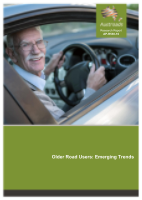Over the next couple of months, with family catching up with elderly parents, Williams OT is going to have a focus on older drivers and road users. We will discuss over the coming months ways that families, general practitioners, and individuals themselves can identify when someone may need to think about reducing driving or regulating their driving, retire from driving or require an assessment to determine whether or not they are fit to continue driving safely on our roads. Williams OT strongly believes that the safety of older road users is pivotal. The population of South Australia is ageing and we are a society set up around the car as our main means of transportation. Therefore, it is essential to have the tools that could help when discussing this emotional subject. We need to recognise when someone should cease driving, but more importantly, we need to highlight the strategies and techniques to improve road safety and reduce the likelihood of road accidents in the older driver cohort.
We are starting the series with a blog post that highlights the main points from the Austroads Research Report “Older Road Users: Emerging Trends”, which was published by Austroads in 2016. The objectives of the report are to identify trends in older road user crash locations, crash types, and injury outcomes, as well as identify whether significant gaps remain in current road safety strategies. The report also aims to inform readers on the development of countermeasures that have been implemented to reduce the incidence of crashes as well as the severity of injury outcomes experienced by older road users.
Williams Occupational Therapy is often getting referrals from concerned general practitioners and worried family members. Referrers are wanting advice and assistance regarding older road users’ safety and when it is ideal for them to cease driving. This Austroads report is a great source for current research and can be a beneficial tool for families and health practitioners.
Due to the length and complexity of some sections of the report we have done the hard work of reading and highlighting the key points and emerging trends for you. Therefore, the following sections are what we perceive as some of the most critical aspects of the article that will be relevant to our readers.
Safety of older road users
It has been recognised that the safety and mobility requirements of older adults (75 years and older) are optimised if they remain licensed to drive for as long as they feel confident to do so. Thus, as long as the individual feels comfortable, safe and confident enough to continue driving, it should be encouraged by all involved that they stay on the roads. However, if family members or their doctor feels that the individual may require a driving assessment it is recommended that they are referred for peace of mind and to provided the older driver with reassurances that they are capable of continuing to use the road. It is highly recommended by Williams OT that this positive approach be taken to driver assessments. We need to highlight the positives outcomes of a driving assessment, rather than the assessments always being about taking a client’s license away.
Testing vehicle safety
The article highlighted that educational programs directed at older drivers can emphasise the advantages of driving a newer, safer motor vehicle. It is also recommended that older drivers aim for a 5 star ANCAP or UCSR safety rating where possible. With the advancements in technology, vehicle safety has increased exponentially recently, making safe vehicles and modifications more affordable and accessible. These advances in vehicles are seen as strong enhancers for staying on the road for many more years than driving older vehicles in the not so distant past.
In order to further protect older adults on the road, authorities have begun to encourage the testing and evaluation of in-vehicle technologies that have been designed to prevent collisions with pedestrians. Additionally, Governments and jurisdictions have considered supporting changes to crash testing protocols so that they better incorporate the requirements of older drivers.
Program implementation to improve safety
The introduction of programs to improve safety at intersections through the reduction in intersection complexity (including the elimination of right turns requiring gap acceptance decisions) is encouraged to improve confidence and safety of older drivers. Also, the implementation of programs to improve intersection safety through speed limit reductions and the use of traffic calming measures, e.g. plateaus, have also been recommended. Such changes to the road environment will provide improved safety to both older road users and pedestrians alike, providing reassurance to family members when older members of the community are out and about on the road.
Educating older drivers
Educational programs aimed at older road user safety have proven to be effective. Education programs that include discussions of self-regulation and reinforcing the benefits of avoiding difficult driving situations has been seen to be highly benificial. Moreover, discussions regarding assisting others through the transition from driving are encouraged, with emphasis on family and friends stepping in to assist with meeting mobility needs.
These programs can also be beneficial for a concerned family member or friend to attend, as they will be provided with relevant information that they can relate to their family member or friend’s situation. Additionally, if appropriate, they can direct questions to personnel that will be able to provide them with direct answers to their concerns.
Williams OT are aware that associations such as the Stroke Foundation, Alzheimer’s Association to name just two, have community information to assist in this area.
Support for when no longer able to drive
As mentioned, there may come a time when an older road user is unable to get behind the wheel. If the individual does not have family or a friendship network to help with their mobility requirements, the risks of social isolation are major concern. It is recommended that Government bodies support the development of resources and alternative transport options. This will not only assist individuals without family or friends support during the transition, but also with ongoing mobility for older adults that experience difficult ceasing driving.
What did we learn?
Road safety is essential for all road users, including both drivers and pedestrians. It is critical that older drivers, in particular, are aware of their capabilities and recognise when they may require re-assessment of their road skills or when to cease driving altogether.
We recommend that concerned spouses, family members, or health practitioners read the Austroads 2016 Research Report on Older Road Users: Emerging Trends for an in-depth evaluation of the evidence supporting older road users safety. But make sure you have had a strong coffee and you have a comfy chair. It is a long read. Better yet, there has now been a webinar uploaded for you to watch. You can otherwise get in touch with Williams OT in one of our many formats to discuss your concerns and how we could assist in this area.
Our next blog post, due to be released next month, will identify specific tools to assist in deciding when to stay on the road or when to retire from driving. If subscribe to our emails, you will be notified of the release of our next blog post as well as receive an invite to our regular community Q and A sessions where drivers, concerned family members and medical professionals can have their questions answered.
About the author
Emily Newbold is a Master of Occupational Therapy student at Flinders University, Adelaide. She has been working at Williams OT since January 2016 as an administration and research assistant. Emily has consequently gained valuable knowledge about the occupational therapy field and business. She has always had a passion for helping others and has thoroughly enjoyed her studies thus far. She looks forward to graduating soon and experiencing the many diverse areas of occupational therapy, as well as hopefully returning to the country to work.



